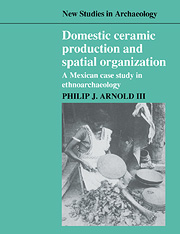1 - Introduction
Published online by Cambridge University Press: 02 December 2009
Summary
Most archaeologists would agree that craft specialization is an integral component of increasing socioeconomic complexity. The occurrence of specialized craft production has served as a perennial favorite for discussions involving social stratification, economic exchange, and ultimately state-level organization (e.g. Brumfiel and Earle 1987; Childe 1950; Wright 1986:323–324). In fact, craft specialization could be characterized as the workhorse of archaeological investigations into complex society. Specialized production, as exemplified in an almost bewildering variety of material manifestations, has been used to monitor administrative influence over production (Feinman, Kowalewski, and Blanton 1984; Spence 1986), the development of interand intra-regional trading networks (Rathje 1975; Wright and Johnson 1975), and various characteristics of the producer/consumer relationship, including the degree of producer competition (Feinman et al. 1981) and the existence of elite consumers (Rice 1981:223).
Given its central role in interpreting social complexity, it is not unreasonable to also consider how craft specialization is viewed archaeologically. What methods have been advocated to identify craft production? What interpretive models have been advanced to meld these archaeological data into an understanding of the past?
The present work employs ceramic production data to address these questions. Ceramics were chosen for several reasons: (a) their positive correlation with sedentism and complex society (e.g. Rice 1987:190; Skibo et al. 1989:126); (b) their almost exasperating quantity as archaeological data (e.g. Willey 1961:230; Sullivan 1988: 23); and (c) their potential as vehicles for interpreting past production organization (e.g. Arnold 1985; Kramer 1985; Rice 1987).
- Type
- Chapter
- Information
- Domestic Ceramic Production and Spatial OrganizationA Mexican Case Study in Ethnoarchaeology, pp. 1 - 8Publisher: Cambridge University PressPrint publication year: 1991



